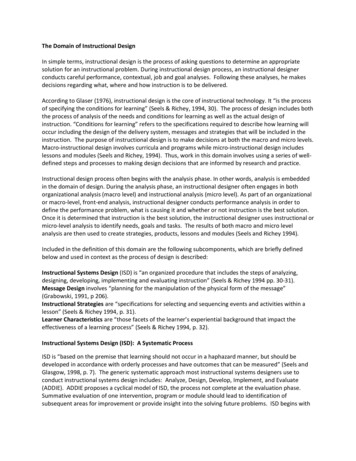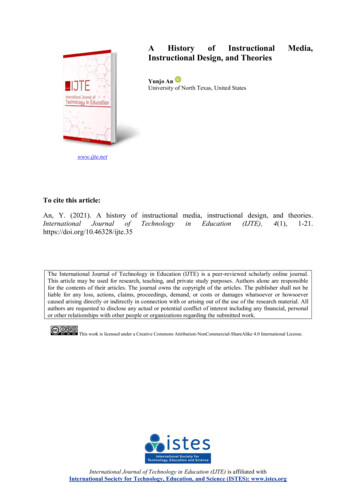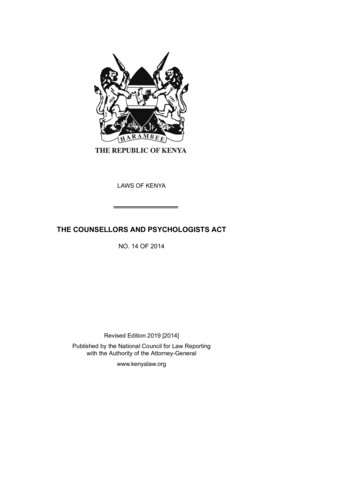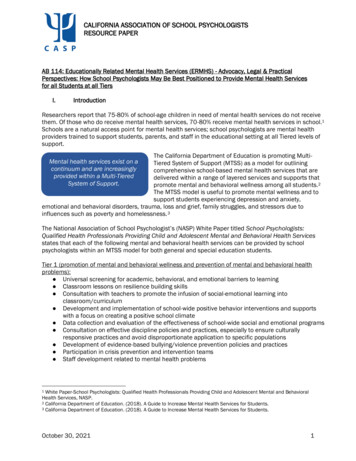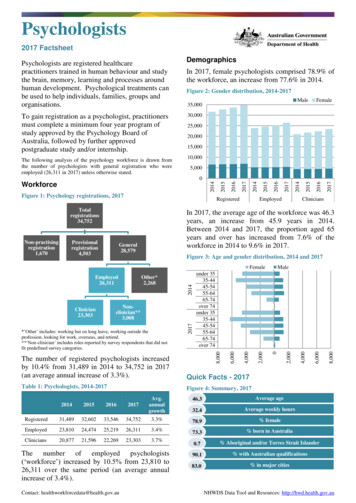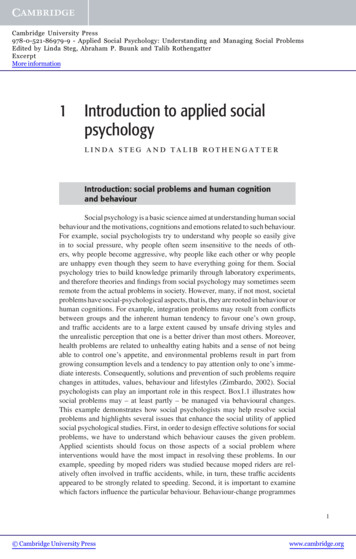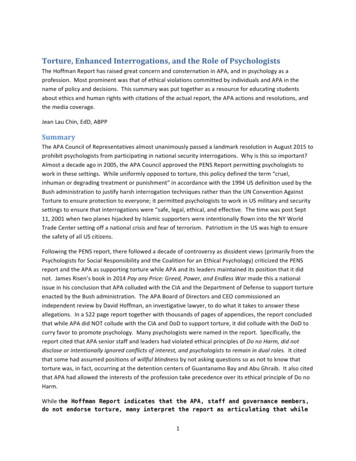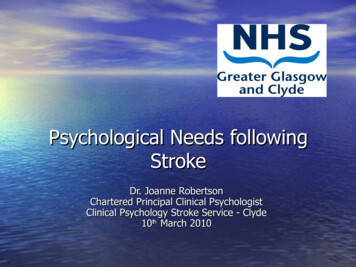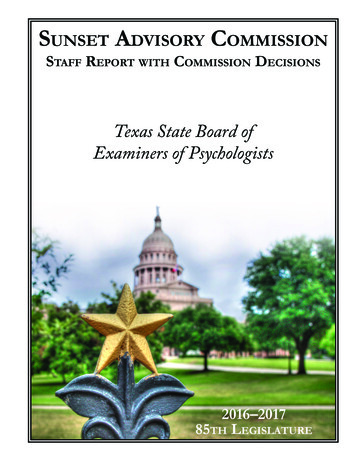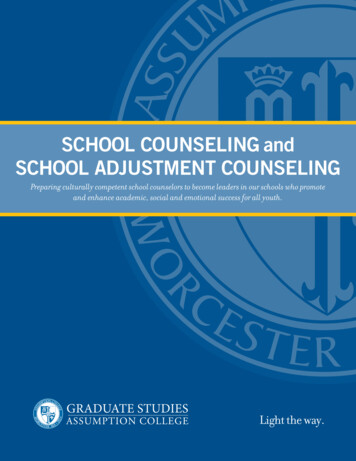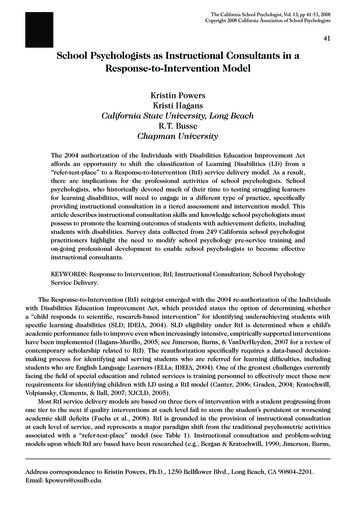
Transcription
The California School Psychologist, Vol. 13, pp 41-53, 2008Copyright 2008 California Association of School Psychologists41School Psychologists as Instructional Consultants in aResponse-to-Intervention ModelKristin PowersKristi HagansCalifornia State University, Long BeachR.T. BusseChapman UniversityThe 2004 authorization of the Individuals with Disabilities Education Improvement Actaffords an opportunity to shift the classification of Learning Disabilities (LD) from a“refer-test-place” to a Response-to-Intervention (RtI) service delivery model. As a result,there are implications for the professional activities of school psychologists. Schoolpsychologists, who historically devoted much of their time to testing struggling learnersfor learning disabilities, will need to engage in a different type of practice, specificallyproviding instructional consultation in a tiered assessment and intervention model. Thisarticle describes instructional consultation skills and knowledge school psychologists mustpossess to promote the learning outcomes of students with achievement deficits, includingstudents with disabilities. Survey data collected from 249 California school psychologistpractitioners highlight the need to modify school psychology pre-service training andon-going professional development to enable school psychologists to become effectiveinstructional consultants.KEYWORDS: Response to Intervention; RtI; Instructional Consultation; School PsychologyService Delivery.The Response-to-Intervention (RtI) zeitgeist emerged with the 2004 re-authorization of the Individualswith Disabilities Education Improvement Act, which provided states the option of determining whethera “child responds to scientific, research-based intervention” for identifying underachieving students withspecific learning disabilities (SLD; IDEIA, 2004). SLD eligibility under RtI is determined when a child’sacademic performance fails to improve even when increasingly intensive, empirically supported interventionshave been implemented (Hagans-Murillo, 2005; see Jimerson, Burns, & VanDerHeyden, 2007 for a review ofcontemporary scholarship related to RtI). The reauthorization specifically requires a data-based decisionmaking process for identifying and serving students who are referred for learning difficulties, includingstudents who are English Language Learners (ELLs; IDEIA, 2004). One of the greatest challenges currentlyfacing the field of special education and related services is training personnel to effectively meet these newrequirements for identifying children with LD using a RtI model (Canter, 2006; Graden, 2004; Kratochwill,Volpiansky, Clements, & Ball, 2007; NJCLD, 2005).Most RtI service delivery models are based on three tiers of intervention with a student progressing fromone tier to the next if quality interventions at each level fail to stem the student’s persistent or worseningacademic skill deficits (Fuchs et al., 2008). RtI is grounded in the provision of instructional consultationat each level of service, and represents a major paradigm shift from the traditional psychometric activitiesassociated with a “refer-test-place” model (see Table 1). Instructional consultation and problem-solvingmodels upon which RtI are based have been researched (e.g., Bergan & Kratochwill, 1990; Jimerson, Burns,Address correspondence to Kristin Powers, Ph.D., 1250 Bellflower Blvd., Long Beach, CA 90804-2201.Email: kpowers@csulb.edu.
42The California School Psychologist, 2008, Vol. 13& VanDerHeyden, 2007; Rosenfield, 2002) and used in practice for many years in states such as Iowa (Ikeda,Rahn-Blakeslee, Niebling, Gustafson, Allison, & Stumme, 2007), Minnesota (Marston, Lau, & Muyskens,2007), and Illinois (Peterson, Passe, Shinn, & Swerdlik, 2007). Despite being practiced and researched,RtI remains relatively new to many school psychologists; as such their knowledge and ability to supportempirically based instruction and monitor a child’s response to that instruction may be limited. However,school psychologists’ knowledge of assessment and access to multiple instructional contexts makes themideal candidates to assume the role of instructional consultant. In short, to move from a refer-test-place modelto a RtI model of service delivery, school psychologists must move from providing primarily psychometricservices to delivering consultation services within a tiered instructional model.TABLE 1
School Psychologists as Instructional Consultants43The purposes of this article are to outline the training and professional development needs of schoolpsychologists for successful implementation of a RtI model, with particular emphases on the theoretical andpractical components of early identification and intervention with students with academic skill deficits (i.e.,Tiers 1 and 2). We begin with the results of a survey of California school psychologists that highlights theneed for practitioner training in RtI methods.California Practitioner Survey ResultsThe description of school psychologists engaged in instructional consultation within an RtI modelcontrasts sharply with contemporary practices. Currently, psychometric models dominate schoolpsychological practice, with a focus on determining eligibility rather than identifying and monitoringinstructional interventions (President’s Commission on Excellence in Special Education, 2002; Reschly,Hosp & Schmied, 2003; Reschly & Ysseldyke, 2002). A 2005 on-line survey by Busse, Leung, Powers andSiembieda, completed by 249 California school psychologists, highlighted the paucity of psychologists engagedin activities related to instructional consultation (i.e., utilizing curriculum-based assessments, evaluatingintervention effectiveness with progress monitoring data). All members of the California Association ofSchool Psychologists (CASP) were invited to complete the survey via email. The response rate was quitelow; less than 10% of the approximately 3000 CASP members responded, and thus, the results should beinterpreted accordingly.The survey results presented in Table 2 indicate most respondents remained heavily engaged intraditional psychometric testing and few engaged in practices related to instructional consultation. Forexample, 79% of respondents administered a cognitive test at least once a week, whereas 2% administereda curriculum-based (CBM) measure as frequently, which can be used for determining students’ responseto instruction. The majority of respondents indicated that they “never” engaged in assessment activitiesrelevant to instructional consultation. Lack of knowledge appears to be a major reason respondents did notengage in instructionally related assessments, as 16% indicated they do not know how to use CBM data, 24%expressed a lack of knowledge on graphing data, and 35% noted they did not know how to apply decision rulesto analyze trends in progress monitoring data. In contrast, out of the 249 respondents, not a single schoolpsychologist indicated that they knew next to nothing about cognitive testing. The survey results indicatethat most respondents engaged in consultation with teachers, and 41% did so on a regular basis. The highpercentage of psychologists who indicated that they did not know how to engage in instructionally relevantassessment activities is startling. With little to no progress monitoring data collected and minimal knowledgeand experience in providing academic interventions (only 7% frequently provided academic interventionsand 1 in 10 respondents reported knowing very little about academic interventions), the effectiveness ofrespondents’ consultation is questionable.School psychologists’ under-developed instructional consultation skills is not solely a Californiaphenomenon. School psychologists across the nation have reported valuing instructional consultationmore than they actually provide this related service; and those who have assisted in academic interventiondevelopment reported they rely on experiential rather than empirical knowledge to inform interventiondevelopment (Porter, Batsche, Castillo, & Witte, 2006). For example, like California school psychologists, mostpractitioners responding to a similar national survey indicated they never engaged in progress monitoring todetermine the effectiveness of interventions they helped to develop (Porter et al., 2006).
44The California School Psychologist, 2008, Vol. 13TABLE 2CASP Practitioner Survey ResultsSchool psychologists must be trained to engage in these assessment and intervention activities to meet thefull intent of RtI provisions of IDEIA 2004. Knoteck (2007) states that the basic skills needed to successfullyoperate within a RtI model are problem-solving skills, ability to successfully exchange ideas, data collection,and analysis of curriculum and instruction. Because most school psychologists do not regularly engage ineven the most basic assessment and instructional programming activities related to RtI (i.e., gathering CBMdata, graphing data, making data-based decisions), there is a great need to train school psychologists whoare knowledgeable about basic and advanced assessment (i.e., experimental analysis of academic behavior,curriculum-based evaluation, dual-discrepancy criterion) and intervention methodologies.Theoretical Assumptions of RtIGenerally, there are two assumptions inherent in a RtI model that drive the selection and implementationof assessment and intervention procedures: (a) interventions represent testable hypotheses that must beevaluated for each student, and (b) implemented interventions focus on alterable contextual variables thatempirically relate to improved student outcomes (Hagans-Murillo, 2005). Conceptually, RtI methodology isbased on the applied behavioral analysis (ABA) and single-subject research literature that promote the useof direct ongoing methods of assessment that measure socially important behaviors to make intra-individual,idiographic comparisons to evaluate the effectiveness of interventions (Baer, Wolf, & Risley, 1968; Gresham,
School Psychologists as Instructional Consultants452007). Additionally, RtI’s grounding in an ecological systems theory is based on the assertion that childoutcomes are influenced by a reciprocal interaction between student characteristics and environmentalconditions (Powers, Hagans, & Miller, 2007). As a result, the focus of the problem does not reside solelywithin the child and instead moves to an analysis of specific environmental conditions that support orthwart the development of academic competence (DiPerna & Elliott, 2002). Conversely, the identificationand implementation of special education services traditionally operates from a deficit, child-centered model,with an assessment methodology that embraces and largely expects evaluations that measure within-person,unobservable, and unalterable characteristics that may minimally relate to the development of targetedinterventions and improved academic achievement (Ysseldyke, 2002).Although within-child and home variables significantly impact student learning, instructional programsmust be selected based on evidence-based effectiveness with the target student population; systematicallysequenced with new information introduced at a realistic rate; and adequate practice provided to enablestudents to develop accuracy and fluency in applying what they have learned (Carnine, Silbert, Kame’enui,Targer, & Junghohann, 2006). However, a serious misconception of teaching is that teachers simply deliverknowledge or information as prescribed in a curriculum lesson. For struggling learners, dispensing knowledgewithout significant adaptations only serves to promote further failure (Kame’enui & Simmons, 1990). Notall comprehensive instructional programs will meet the needs of all students; some will require modificationsuch as explicit skill demonstrations and guided practice. Highly qualified school psychologists can providean important related service by sharing knowledge of empirically based strategies with teachers who aredelivering instruction to struggling students.Scientific Support for RtIAlthough convergent research over the past decade specifies essential ingredients for effective instruction(e.g., National Reading Panel, National Literacy Panel, President’s Commission on Excellence in SpecialEducation, National Council on Teacher Quality), an extensive gap exists between research and practice(National Council on Teacher Quality, 2006). There is a need to assist teachers in the design and deliveryof instruction to provide quality instructional programs to diverse learners, especially students who enterschool with varied formal and informal learning experiences. Additionally, instructional assistance is neededto help special education teachers provide quality and adequate instructional programs to increase specialeducation exit rates of students already identified with a disability (Powers, Hagans, & Miller, 2007).Instructional consultation is a collaborative problem-solving process focusing on general or specialeducation teachers’ concerns regarding the academic progress of individual or groups of students, or thefailure of instructional programs to improve student outcomes (Rosenfield, 2002). The primary goal ofinstructional consultation is to create and maintain student success within the general education environmentby supporting classroom teachers’ application of evidence-based instruction and assessment to supportstruggling learners (Gravois & Rosenfield, 2006). To meet this goal, consultants must possess knowledge inthe design and delivery of instruction, collaborative problem-solving skills, and the ability to analyze studentdata to inform instructional decisions.The promise of RtI is much more than a new set of criteria for qualifying students for special educationservices. RtI is a model for providing primary, secondary and tertiary academic interventions to studentswith reading, writing, and mathematics deficits. Torgeson (2007) described RtI as:“ a complete model for organizing and delivering early reading instruction inelementary schools. In fact, it could be called the “response to intervention instructionalmodel,” as distinct from the “response to intervention diagnostic approach” which isreferred to in the (IDEA) legislation” (p. 1, italic emphasis added).Torgeson’s intervention research found that applying a RtI model in the form of ensuring high qualityinstruction to all students, modifying academic interventions based on progress monitoring data, andproviding “increasingly powerful ‘tiers’ of intervention based on student need” decreased the numbers of
46The California School Psychologist, 2008, Vol. 13students exhibiting severe underachievement. For example, in a study with 318 elementary schools in Florida,Torgeson reported that the proportion of Kindergarten students identified as having a learning disability wasreduced by 81% within 3 years of applying the model. Similarly, the proportion of third grade students withsignificant reading difficulties was reduced from 26.7% during the first year of RtI implementation to 19.9%at the end of the third year. These results are consistent with previous research findings (Burns, Appleton,& Stehouwer, 2005; Jenkins, Peyton, Sanders, & Vadasy, 2004; Kovaleski, Gickling, Morrow, & Swank, 1999;VanDerHeyden, Witt, & Barnett, 2005) on the efficacy of RtI service delivery models for reducing graderetentions, referrals for special education, and increasing reading, spelling, and math skills.Furthermore, research on RtI as a diagnostic service delivery model on the overrepresentation ofminorities in special education is encouraging. Marston, Muyskens, Lau, and Canter (2003) found thatreplacing the “refer-test-place” service delivery model with RtI reduced disproportional representation ofculturally and linguistically diverse students in special education in the Minneapolis Public School District.Similarly, Gravois and Rosenfield (2006) found a significant decrease in the risk of minority students beingreferred or found eligible for special education among schools that implemented instructional consultationteams.Successful implementation of RtI is predicated on the ability of educators to identify evidence-basedinstructional practices for implementation at multiple instructional tiers, and the use of progress monitoringsystems to gauge student progress and need (Glover & DiPerna, 2007). School psychologists are uniquelypositioned to assist in the implementation of a tiered instructional model through the provision of instructionalconsultation services at each tier of the RtI instructional hierarchy, thereby fulfilling IDEIA mandates whileimproving the academic outcomes of struggling learners.INSTRUCTIONAL CONSULTATION IN A THREE-TIERED RTI MODELThere exists variation in how the three tiers of RtI are conceptualized, and no model has been shownto be superior to another (Burns, Deno, & Jimerson, 2007). Regardless of the model, the basic tenets of RtIare implementing increasingly intense interventions suitably matched to students’ needs based on a failureto respond to less intense intervention. For example, in some models the provision of special educationservices is considered the third tier, whereas in others’ tier 3 is another opportunity to remediate a student’sacademic deficit before determining that the child likely has a disability and requires special educationservices to make adequate progress in school. Therefore, depending on one’s conceptualization of RtI, someassessment and consultation activities may fall within a different tier upon implementation. Potential schoolpsychologist activities and contributions to the implementation of RtI in the schools within a three tieredinstructional consultation approach are numerous (see Table 3). However, for the purposes of this article, wefocus on describing Tier 1 and 2 activities and competencies because these levels typically are most conduciveto instructional consultation as a method for ameliorating the need for special education placement.
School Psychologists as Instructional Consultants47TABLE 3Tier 1 Instructional Consultation ServicesTier 1 assessment and intervention typically take place in the general education program and involvecollaboration among many individuals, including the school psychologist. Ideally, Tier 1 includes effectivedelivery of a rigorous and empirically based curriculum, universal screening at least three times a year forearly identification of students in need of intervention, and a standard protocol instructional interventionfor students who fail to meet targeted universal screening benchmarks (Fuchs & Fuchs, 2006). Students mayfail to achieve identified academic standards if these instructional components are not effectively in placeor poorly implemented. School psychologists are in an ideal position to provide consultation to teachersregarding instructional delivery, classroom management, collecting and interpreting student data, andmaking data-based decisions regarding student educational needs and progress due to the training schoolpsychologists receive in collaborative consultation, assessment linked to intervention, and understanding oflearning and behavior.Instructional Delivery. The research literature consistently demonstrates the powerful influence ofinstructional quality on achievement (Brophy & Good, 1986; Rosenshine & Stevens, 1986; Vaughn, Gersten,& Chard, 2000). Instructional quality, in turn, is affected by variations in teacher preparation and experience.Even teachers who have completed a credential program may not be prepared to provide effective instruction.For example, the National Council on Teacher Quality (NCTQ, 2006) found that many teacher preparationprograms do not prepare teachers to provide reading instruction based on empirically validated methods.In this study, the NCTQ randomly selected 72 elementary education preparation programs from across thenation and reviewed over 200 syllabi from these programs. They found only 11 of the 72 schools includedat least one syllabus that referenced the five components of effective reading instruction (i.e., phonologicalawareness, alphabetic principle, fluency, comprehension, and vocabulary), as cited by the National Reading
48The California School Psychologist, 2008, Vol. 13Panel (2000). Although there has been substantial convergent research over the past decade to specifythe essential ingredients for effective instruction, particularly reading instruction, (e.g., National ReadingPanel, National Literacy Panel, President’s Commission on Excellence in Special Education), the NCTQfound few elementary education courses adhered to current scientific evidence. Furthermore, an emphasison providing teacher preparation courses that are “fun” at the expense of rigor was found to undermineteachers’ preparation (NCTQ, 2006). School psychologists can assist teachers in the delivery of effectiveinstruction by directly observing and providing consultation to improve the classroom environment andinstruction, and subsequent student learning.Key indices of quality instruction (e.g., clear learning objectives, adequate and varied practice,immediate and specific feedback) may be assessed through direct observation of instruction and/or the useof published ecological assessments. During classroom observations, various time-sampling and frequencyobservation procedures may be used to analyze the instructional environment for factors known to impactlearning, such as sufficient opportunities for students to respond to instruction, pacing of instruction, preteaching potentially difficult tasks, and maintaining students’ attention during instruction (Kame’enui &Simmons, 1990; Salvia & Ysseldyke, 2007). The Functional Analysis of Academic Behavior (FAAB; Ysseldyke& Christenson, 2002), a published, semi-structured observation and interview tool, may be used to gatherinformation on the interaction between a student and his or her learning environment, such as realistic buthigh student expectations, use of effective motivational strategies, and reasonable curriculum modification toaccommodate specific instructional needs. Additionally, the degree to which a student’s home environmentsupports learning is assessed, such as parent participation in learning at home or school, daily routines tofacilitate completion of assignments, and perceptions of the value of education. Using data derived from bothstructured and unstructured observations, school psychologists and teachers can collaboratively identifyways to improve the content, delivery, and/or management of instruction to increase student achievement.Measuring student engagement during instruction is another important consideration when attemptingto identify learners’ academic difficulties because of the strong positive relationship between the amountof time a student is actively engaged in learning activities and his or her achievement (Greenwood, 1991;Shapiro, 2004). Student engagement, or academic learning time, is the proportion of time a student is activelyand successfully engaged in a learning task, such as writing, reading aloud or silently, and answering or askingquestions. Convergent research evidence shows that students who are actively engaged during instructionexperience more opportunities to respond to instruction, resulting in higher levels of achievement (DiPerna,Volpe, & Elliott, 2002). Factors such as instructional design and classroom management play a major rolein students’ rates of academic engagement. School psychologists have the opportunity to assist teachers inidentifying and modifying variables in the classroom environment to maximize student learning (Gettinger& Seibert, 2002). A structured observation tool, such as the Behavioral Observation of Students in Schools(BOSS; Shapiro, 2004), may be used to measure students’ engagement during instruction by observing thepercent of time a student is actively or passively engaged, and off-task during instruction compared to apeer. Operational definitions of the above behaviors must be developed by the observer prior to observation.Response accuracy also should be assessed by examining student work (e.g., permanent products) todetermine the instructional match and success of the student in the expected material.Various interval or time sampling observational techniques are useful for recording continuous andhigh frequency behaviors (Alberto & Troutman, 2003) and are useful for measuring academic engagement.However, an operational definition of “academic engagement” must be developed before employing a timesampling observation to ensure that the behavior is measured consistently. A list of specific behaviorsconsidered representative of “academic engagement” may be developed in consultation with the teacher.Behaviors considered the opposite or absence of the behavior of interest (i.e., academic engagement) also areuseful in operationally defining behaviors (Lewis & Sugai, 1999). Subsequently, a specific time period duringwhich the target behavior is likely to occur is determined (e.g., teacher-directed language arts instruction)and divided into equal intervals typically no longer than 30 seconds. Information regarding the occurrence,duration, and distribution of academic engaged time of a student or group of students may be inferred fromthe data (Alberto & Troutman, 2003).
School Psychologists as Instructional Consultants49Universal screening. Most students will make sufficient progress when provided high quality instruction,however, between 3% to 7% fail to respond adequately (Mathes, Denton, Fletcher, Anthony, Francis, &Schatschneider, 2005). The teacher of a class with a large number of underachieving students may requiresubstantial consultation and professional development. To provide timely assistance, academic achievementdata on every student in a school must be collected and compared to identify students who are failing toprofit from general education instruction and curriculum. The results of large-scale assessments, such as theCalifornia Standards Test (grades 2 and up) and California Achievement Test (grade 3 and up), may be usefulfor making curricular changes when the data indicate specific skills are not sufficiently mastered in a gradelevel. However, these data are not collected frequently enough to provide early identification of academicdifficulty for individual students. Test item difficulty also changes with each passing grade level, renderingit difficult to determine student progress. Universal screening of all students in the major academic areas(reading, mathematics, written expression) three times per year would enable school personnel to providea timely response to the first signs of academic difficulty. Fuchs and Fuchs (1999) suggested that universalscreening measures meet the following criteria: (a) sufficient evidence of reliability and validity; (b) capacityto model growth (i.e., multiple alternate forms that allow comparison across administration; sufficient rangeof skills are measured to avoid floor and ceiling effects for students with poorly or highly developed skills);(c) identified benchmarks for expected growth used to set a selection criterion; (d) treatment sensitivity (i.e.,small gains in skill acquisition are detected, and gains can be compared to average growth rates to determinewhether sufficient progress is being made); (e) capacity to inform teaching; (f) independence from a specificinstructional strategy or curriculum (i.e., a universal screening should rely on tasks that are functionallyequivalent to the material that has been directly taught and practiced, but the screening tasks themselvesshould be novel); and (g) feasible (i.e., easy to administer; takes a short amount of time to administer,score, and interpret). Mastery measures, such as Read Naturally assessment tools, reading inventories, andclassroom or text-book tests of learning modules are readily available and therefore, very feasible. However,these instruments lack multiple equivalent forms and thus, impede monitoring of learning across time, andoften are not independent from instruction. Published, norm-referenced tests, such as the Woodcock-JohnsonIII Tests of Achievement, are more independent from instruction, however, they lack treatment sensitivityand often are costly and time consuming to administer and score. Curriculum-Based Measures (CBM),such as Initial Sound Fluency (ISF) or Phoneme Segmentation Fluency (PSF) for measuring phonologicalawareness skills, Oral Reading Fluency (ORF) for measuring reading in connected text, Digits Correct Fluency(DCF) for measuring mathematics, and Words Written Fluently (WWF) or Correct Word Sequence (CWS)for measuring spelling and writing, meet most or all of these conditions (Shapiro, 2004). CBM resourcesmay be found on a number of websites, including the sites for Dynamic Indicators of Basic Early LiteracySkills (DIBELS), AimsWeb, and Intervention Central. Although some curricula include progress monitoringmeasures for use by teachers, few teachers engage in progress monitoring due to time constraints (Bentz& Shinn, 1990), or aren’t fully trained on how the assessments inform instruction or how to interpret theresults so they can use the data to alter their instruction.(Santi & Vaugh, 2007). By familiarizing themselveswith these resources and the empirical literature on CBM, school psychologists can be central figures inselecting appropriate measures for universal screening of all students in basic skill areas to inform instruction.Tier 2 Instructional Consultation ServicesTier 2 involves a more refined definition of a student’s academic problem, greater analysis of potentialcauses of the deficit, and more intense, empirically based interventions (Fuchs & Fuchs, 2006). Accordingly,school psychologists who provide instructional consultation may need to (a) co
The California School Psychologist, 2008, Vol. 13 School Psychologists as Instructional Consultants TABLE 2 School psychologists must be trained to engage in these assessment and intervention activities to meet the full intent of RtI provisions of IDEIA 2004. Knoteck (2007) states that the basic skills needed to successfully
